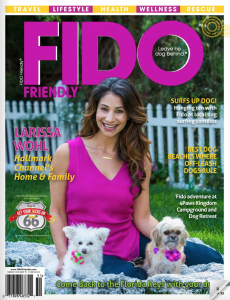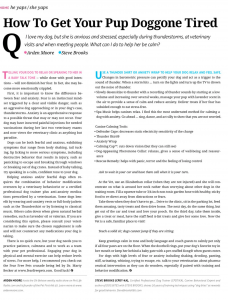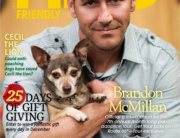Q: I love my dog, but she is anxious and stressed, especially during thunderstorms, at veterinary visits, and when meeting people. What can I do to help her be calm?
Use a thunder shirt or anxiety wrap to help your dog relax and feel safe. Changes in barometric pressure can petrify your dog and act as a trigger to the sound of thunder. When a storm hits … turn on the lights and turn up the TV to drown out the noise of thunder.
- Slowly desensitize to thunder with a recording of thunder sounds by starting at a low volume and increasing over several weeks, massage your pup with lavender scent in the air to provide a sense of calm and reduce anxiety. Deliver treats if her fear has subsided enough to eat stress free.
- Spa Music helps canines relax. I find this the most underrated method for calming a dog with anxiety. Go ahead … sing, dance, and act silly to show that you are not worried.
Canine Calming Tools:
- Defender Cape: decreases static electricity sensitivity of the charge
- Thunder Shirt(R)
- Anxiety Wrap
- Calming Car’: cuts down vision (but they can still see)
- Dog-Appeasing Pheromone Collar: relaxes, gives a sense of well-being and reassurance
- Rescue Remedy: helps with panic, terror and the feeling of losing control
Ask to wait in your car and have them call when it is your turn.
At the Vet, use an Elizabethan collar (when they are not injured) and she will concentrate on what is around her neck rather than worrying about other dogs in the waiting room. Fill a squeeze tube or 3/4-inch non-toxic garden hose with healthy, sticky food to redirect away from distractions or fears.
Take them when they don’t have to go… Drive to the clinic, sit in the parking lot, feed them amazing, tasty treats and then drive home. The next day, do the same thing, but get out of the car and treat and love your pooch. On the third day. take them inside. give a treat or meal, have the staff feed A-list treats and give her some love. Now the Vet is a safe, familiar place to visit!
Teach a solid sit: dogs cannot jump if they are sitting.
Keep greetings calm in tone and body language and coach guests to calmly pet only if all four paws are on the floor. When the doorbell rings, put your dog’s favorite toy in her mouth or keep her behind a baby gate with a prestuffed Kong(R) when guests enter.
For dogs with high levels of fear or anxiety including shaking, drooling, panting, stiff, urinating, whining, trying to escape. etc. talk to your veterinarian about pharmaceutical intervention as they can do wonders, especially if paired with training and behavior modification.









